Savory Institute Turkey Hub:
– Food & Climate part 2 –
above: founders Volken (Left), Durukan (right) welcome Allan Savory & Jody Butterfield to Turkey
Prior to leaving for October’s Eisenhower fellowship program in Turkey – I reached out to Allan Savory for advice. I explained my intent and program objectives that correlate the value of better quality food to human and planetary healthcare. Supremely gracious, Allan invited me to their forthcoming global conference happening in San Francisco, which happened coincide with the same weekend I was leaving for Turkey. Equally exciting, he informed of work of Durukan Dudu – the head and co-founder of The Savory Institute Turkey Hub. Allan suggested I make time to visit Durukan and team on the Anatolian Grasslands during the research program in October. The Savory Institute has established disciples throughout the world through the launch of international hubs to promote, teach and evolve best holistic practice through returning animals to working lands. Allan has earmarked and invested in future leaders interested in progressing the previously described mindset, and I’ve come to learn that Durukan Dudu was one of these intelligent and passionate thought leaders evaluating anti-desertification methods in Biga Turkey. Immediately enthralled, my program managers and I integrated a visit into the fellowship.
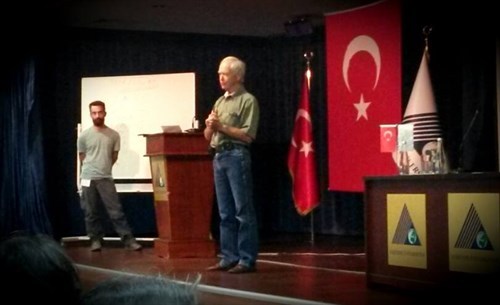
(Allan and Durukan presenting food & climate plans & findings in Istanbul)
Fitting a visit in between Durukan’s return from the Savory national conference in San Francisco, and my traversing of the Turkish countryside – we orchestrated a time to meet and tour the Savory Institute Turkish hub in the middle of the month. I must say, as I made the drive to Biga from Bursa I was very excited for this opportunity. Despite the Anatolian Grasslands Savory Institute research-hub being off the beaten path – it was in a pretty epic location near where the mouth of the Sea of Marmara meets the Aegean sea. Somewhat strangely, driving through the terrain near Biga reminded me not of other parts of arid Turkish topography I saw earlier in the Northeastern part of the country, nor a mediterranean landscape as I witnessed down by Izmir & Ephesus, but the rolling pastoral hills looked a bit like parts of upstate NY & Vermont. Stopping a few times to look out over the many trees separating farmlands, most noticeably the beautiful local Oaks that were interspersed in the evergreens throughout this scenic undulating countryside I began to wonder if I was grasping for something that just wasn’t there. I wasn’t homesick yet! I’d later make a few comments relating to what I saw, but I think my vision of some Northeastern roots was lost on this international troop deeply immersed in the task at hand – how returning animals to open pasture in Turkey will benefit diverse ecosystems and biodiversity throughout the world. Later, as I took a closer look at the soil tilth and makeup – I realized that despite the resilience of many of the same plants we share, the framework for which they thrive was so very different. Further proof of the power and complexity living soil represents.
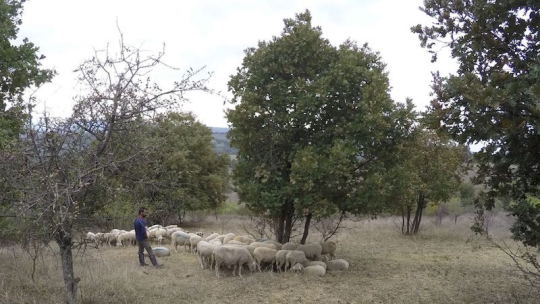
(Durukan & hardworking team of Anatolian watchdogs look over a portion of the flock)
Upon arriving at the research hub in Biga I was welcomed by Durukan and his co-founding partner and cousin Volkan Buyukgungor. We sat on their farmhouse porch at basin of their elevated pasture land and chatted for hours. It seemed we became immediate compatriots. People from halfway around the world aligning on many aspects and sharing a similar vision for the future. They explained all of the hard work they’ve put-in over the past few years cobbling together resources to continue to buy or rent more land while increasing the size of their flock. Turkey is going through an interesting period in agriculture. Unlike the States which has lost, but now finds rejuvenated interest in smaller scale farming, Turkey is in the middle of their own infrastructure discussion. In fact, earlier while in capital city of Ankara I learned from the Agricultural Ministry their growth plan to consolidate many of the small farms that employ 3 Million Turkish farmers through large scale acquisition, or if needed – forced eminent domain. In regions now gaining new water access through a large scale commitment to dams equally for hydro and irrigation purposes this is creating new socioeconomic and political issues. This will pan out with interesting results in the next few years especially in the Gap region in southern Turkey that borders much of Syria. Heavily inhabited by Kurds, this brewing tinderbox will have to be closely watched especially with the AK party’s re-election and track-record in flexing their muscles when something is deemed to benefit the State.
Biga is different than the Gap region, and despite the aesthetic of a Update New York landscape – it’s very different than the US. For that matter, so is most of the current farming infrastructure in Turkey. That said, our common ground is finding a happy medium in production scale, despite coming at it from completely opposite directions. The vast majority of Turkish farms are smaller farms, which actually continues to grow further splintered through succession plans of generations inheriting smaller and smaller parcels and further splitting working lands as each child gets a piece of the action. We like to claim that in the US 97% of farms are family owned, but when you break down total production volume – that statistic is mostly fluff as the vast majority of production in the US is from very large farms, often leased from an entity (I will follow with further essays delving deeper). In Turkey, total production volume and the number of small farms do correlate. As they try to figure out a new identity that will allow gross agricultural revenue to increase from current $50B to predicted $150B by 2023 – change seems inevitable despite domestic consumers not necessarily correlating to the Ministry’s plan to adopt a Western production model of producing volumes of cheaper food at the sacrifice of nourishment and employment.
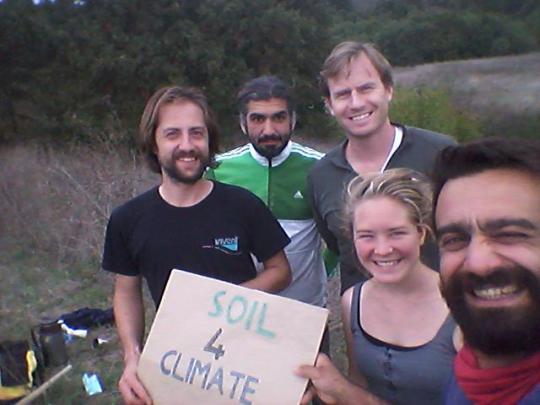
(I join Volkan, Durukan and team for a quick photo shoot on the grasslands)
After a wonderful lunch of all farm-grown produce, homemade cured meats and pomegranates (something you won’t find in Vermont) picked from the tree in the backyard – we headed up into the pasture to explore, see the flock and learn more. Visiting these animals is so important. A noble life indeed! The holistic relationship of the soil, plant and animal mentioned in Part 1 – fixing the broken link in the chain by re-assimilating our ruminant friends back onto the farm is where this whole concept comes into play in Biga, and for every struggling grasslands across the world. Simply, the mutually beneficial ecological evolution of these trophic relationships have built a closed loop feeding cycle that equally supports and affords resilience to each part of the food system no matter how grand or small.
As detailed in the Soil Foodweb diagram presented in Part 1 of the Food & Climate essays – a mentor of mine, Elaine Ingham coined this concept that evaluates and bolsters how the relationship of billions of bugs colonizing healthy soil can work in unison to reform any type of waste stream into plant ready nutrients. That needed starter kit for a successful nutrient cycling program is most perfect when it comes delivered not from synthetic shots of energy from petrochemicals and refined minerals, but instead by feeding the soil with what it has evolved to draw nutrients from – animals. The constant moving and turning of those animals has also worked with natural selection just as we’ve witnessed with macro evolution to afford opportunity for only the strong and proficient to survive when dealing with their larger and now essential ruminant brethren. Effectively, the digestion recycling energy in the belly of cows is just the first step in providing needed energy to the health of living soil.
In and around Biga, where the smaller farms of often authentic practice remain the mainstay, some of Durukan and Volkan’s plans seem in line with generations past. But, as the allure and of the short-horizon gains of modern agriculture envelops their region – many of the farming methods they’ve implemented like no-till, and timed mob grazing – a practice that replicates having predators to keep grazing animals constantly moving appear old-school rather than revolutionary to other farmers in the region. Gaining continued interest on circular farms in the US, this process of mob and pulse grazing moves animals from paddock to paddock in a quick enough period to prevent the animals from destroying too much of the grass (an effort to have the animal eat no more than ½ of the blade during a feeding period, and surely none of the roots) before they are moved onto a next strategically earmarked parcel. Successful examples like the reintroduction of wolves in Yellowstone further prove that it’s about the entire food chain evolution along with grazing animals. The process works especially well with the economics of production agriculture as integrating diversity of species which often prefer different grasses, forbes and seed types on the same fields – can improve stocking densities and revenue stream diversification on regenerative lands. Durukan and Volkan have brought folks from all over Europe and the Middle East to learn from these practices on the Anatolian grasslands. What I find so intriguing, along with the science these guys are implementing to make this work in the field and in the soil, they return to the idea that their methods produce a better tasting product. Which in the long-run I believe makes this concept scalable and desirable to a consumer-base in Turkey, in the States and globally as more consumers return to the fundamental value of food. Taste, nutriment and wholesomeness.
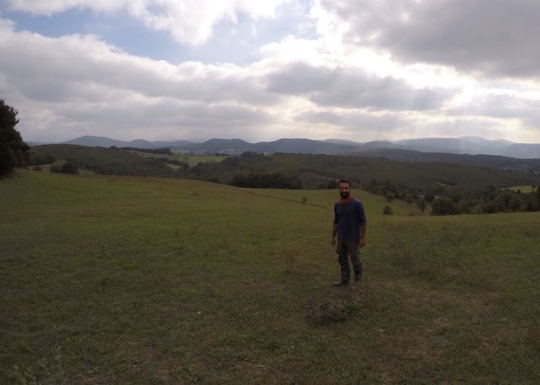
(Durukan stands over the rolling hills of the Anatolian Grasslands in Biga Turkey)
Ecology has become supremely efficient in closing this energy loop – and if what remains left is only the living matter designed to recycle energy and the dander called petroleum – the system that created and stored this energy in the first place is hungry to return itself back to an equilibrium As a systems thinkers – that is just common sense! Although, the described conduit of remediation now get much of the blame through the reductionist mindset. Food animals are now defined as a fundamental driver in climate change equal to human emissions? Well,with current confinement practices – this may be very true. Methane is anywhere from 25 – 85 times more potent an adulterant as compared to carbon dioxide, but the fundamental problem is the nature of the question. The animals are in fact an essential and key part of the solution. As author Judith Schwartz writes in “Cows save the Planet” – the disruptive forces of ruminants are actually the “crucible” of change in using soil to rectify climate change. Conventional methodology and associated reductionist theories to the environment, and our health, fail to evaluate how we’re all part of much bigger system that rely on being part of the living nutrient recycling program. As Allan & Durukan will continue to prove, there will be unlikely heroes in solving global problems through the bettering methods for how we feed ourselves.
ONEHEALTH FOR US ALL
Who the hell wants to be preached to regarding what they eat, or that of their family’s diet. Coming tooled with more & more knowledge of all these problems we’ve got going on and what the future will look like if we continue business as usual – I’ve had to learn how to be a much better dinner date. So, for all that bad, there’s actually incredible hope in rectifying these problems through proven and tested models that utilize the same solution to solve many problems. The best practices of circular agriculture can not only improve the health and welfare of the animal & farm worker, and source cleaner & healthier food but this same process can be our best remedy in healing a quickly warming and choking planet. That is a crazy paradigm shift in evaluating broader scale change that will correlate to many vested interests.
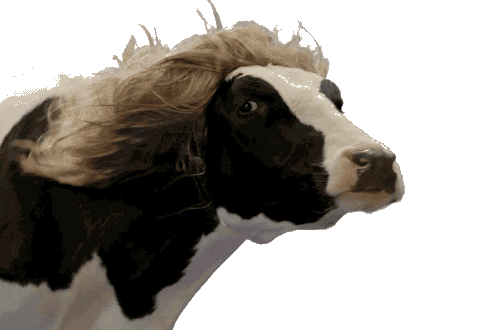
(the value of livestock has never looked so good as on working grasslands)
Whether it’s relating to practice, provenance or benefit – collectively, we’ve long since been food ignorant in the United States. Most times the truth is not what we want to hear, especially when dealing with something as intimate as the food we feed our families. But, the good news is that unlike any other time in history we can rectify a social wrong quickly. Through sustained awareness, education and proper truths that best service collective interests and not that of greed and hubris of a few groups who struggle to see the forest amongst the trees with their repeated claims that conventional production of cheap food has nothing to do with climate change, modern plagues like obesity, heart disease, cancers and that of general poor well-being which has inflicted US populous over the past 30 years – change is brewing. Our natural defense mechanism of common sense has been so desensitized we’ve simply lost perspective on the fundamental purpose of food. Without focus on well-being, cheap caloric energy is proving a killer to our health and that of our planet. We seeing signs of change, and the basis for that change is actually how we came to be in the first place! It’s an exciting time to be ruminant!

